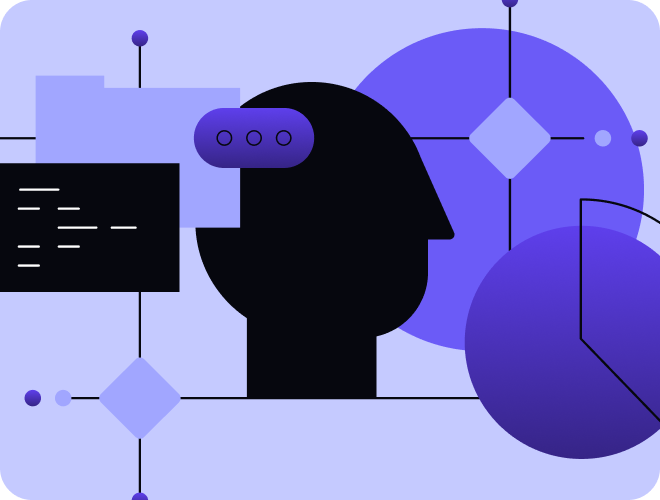How to Integrate AI to a No-Code App on Bubble
.avif)

Do you have a project in mind?


The fusion of AI and no-code platforms like Bubble is changing app development.
Developers can create intelligent applications without extensive coding knowledge by integrating AI capabilities, such as ChatGPT, into Bubble's intuitive framework.
Imagine launching a feature-rich application that interacts with users intelligently, all while bypassing the complexity of traditional coding.
This is now achievable with Bubble no-code, improved by AI.
The platform empowers you to focus on refining user experience and functionality, rather than getting bogged down by technicalities.
As more businesses recognize the potential of AI-enhanced no-code solutions, app development is set to become more inclusive and dynamic.
What is AI, & Why is it Valuable For Apps?
Artificial Intelligence (AI) refers to systems that can analyze data, detect patterns, and make decisions with minimal human input. When added to an app, AI can write responses to users, recommend products, and recognize objects in uploaded videos or images.
Integrating AI means you don’t need custom code or traditional coding expertise to build smart functionality for a Bubble no-code app.
With tools like the Claude API, OpenAI, or other external AI services, even a basic no-code app builder can run features like text summarization, language translation, or image tagging from one Bubble interface.
Using AI lets you save time, improve app performance, and handle tasks that used to require complex code development. Instead of searching for workarounds or worrying about bugs, you can build features that improve the user experience.
AI expands what your app can do, without expanding the effort it takes to create it.
Benefits of Adding AI Capabilities To Your No-Code App
Adding AI to your Bubble app can drastically boost performance and usability without increasing the complexity of your development process.
With the help of AI tools and services like Claude API or GPT-based models, you can create intelligent and responsive features. Whether recommending content, analyzing user data, or handling support tickets, an AI-powered app helps users get value faster, without clicking through endless menus.
For developers using no-code tools, AI integrations reduce the need to write code or learn advanced code development.
Through Bubble’s plugins or API connectors, you can connect external AI services, turning your app into something far beyond a basic prototype.
AI also helps reduce manual errors, automate tasks, and save time, especially useful when working solo or building for a small business. And since no coding is required, you can go from idea to working product much faster than traditional tools.
The best part?
Most AI features work with free or low-cost services, so your app can stay lightweight, smart, and scalable.
Plugins vs. APIs in App Development
When building an AI-powered app on Bubble, you’ll likely face a decision early on: use a plugin or connect directly through an API.
Both options support the same goal: adding smart functionality without custom code, but they work differently.
Plugins are pre-built tools that can be installed with a few clicks. They're perfect for no-code development because they simplify setup and hide technical complexity.
Want to integrate an AI chatbot or embed video search? There’s probably a plugin for that.
APIs, on the other hand, give you direct access to external services like OpenAI or Claude. They offer more control but require more setup. You’ll need to create API calls, manage authentication, and manually define how data moves between systems.
A plugin is faster. An API is more flexible.
For many Bubble developers, it comes down to project scope. If you’re testing an idea, start with plugins. If you’re building for scale or need precise integration details, APIs give you that freedom, without the overhead of writing code from scratch.
5 Steps to Integrate ChatGPT & AI Chatbot into a No-Code Bubble App
Step 1: Set Up an API Connector
The first step in integrating ChatGPT and an AI chatbot into your Bubble no-code app is setting up an API Connector. API connectors connect your app with external APIs, such as OpenAI, enabling smooth data exchange.
Begin by installing the API Connector plugin from the Bubble plugin directory. Once added, configure it to facilitate communication with the desired API. This setup expands your app’s capabilities and empowers you to use cutting-edge AI technology, enhancing user experiences.
Remember, a smooth API connection is crucial for efficient AI integration and for establishing the foundation for advanced app functionalities.
Step 2: Obtain an OpenAI API Key
The next crucial step in integrating ChatGPT into your Bubble no-code app is obtaining an OpenAI API key.
Start by registering on OpenAI's platform, which is straightforward. Once registered, you'll receive an API key that grants access to ChatGPT's powerful services. This key is a gateway to adding AI-driven features to your app, ensuring it can interact intelligently with users.
Securing this key is fundamental for opening the full potential of AI capabilities in your application.
Step 3: Configure the API Connector
Now that you've obtained your OpenAI API key, it's time to configure the API Connector in your Bubble no-code app.
You can begin by accessing the plugin settings and inputting your API key. This establishes a secure communication channel between your app and OpenAI's services.
Next, define the API calls that will handle user inputs and responses. For instance, when a user asks your chatbot a question, the API call sends this input to ChatGPT. Upon receiving the response, the API Connector ensures it is presented meaningfully to the user.
This configuration is key to creating a smooth interaction. It enables your app to process natural language inputs effectively and deliver accurate AI-driven responses. Setting this up correctly is crucial for a functional and intelligent application.
Step 4: Design Your Chat Interface
Creating an engaging chat interface in your Bubble no-code app involves utilizing Bubble’s intuitive editor. Begin by arranging the layout with user-friendly input fields where users can easily type their queries. It’s essential to position these fields in a natural and comfortable way for user interaction.
Next, designate clear response areas where the AI-generated answers will appear. This ensures users can follow the conversation flow seamlessly. Consider incorporating design elements like color coding or icons to differentiate between user input and AI responses, enhancing clarity.
As you build this interface, consider the importance of accessibility and simplicity, ensuring it caters to various user needs. Testing the interface with a small group can provide feedback on usability, helping refine the design.
Step 5: Develop and Test Workflows
Developing and testing workflows is the final step to ensure your Bubble no-code app communicates effectively with ChatGPT.
Start by designing workflows that align with your app’s user interaction goals. These workflows should handle different conversational scenarios, from basic queries to complex interactions.
For instance, map out the actions when a user sends a message. This includes triggering the API call, processing the response, and displaying it to the user.
Once your workflows are set, thorough testing is crucial. Simulate various user interactions to identify potential issues or bottlenecks in communication. Testing should cover response time, accuracy, and overall user experience. Iteratively refine your workflows based on testing feedback, ensuring they are robust and reliable. By prioritizing a smooth interaction process, your app will deliver a seamless AI-driven experience, enhancing user satisfaction and engagement.
Conclusion
Incorporating AI into your Bubble no-code app opens a world of possibilities. By leveraging AI tools like ChatGPT, you can enhance your app's interactivity and intelligence, providing users with dynamic and context-aware responses. This integration improves user satisfaction and sets your app apart in a competitive market.
As you dive into this transformation, remember that experimentation is key. Testing configurations and workflows will help refine your AI features, ensuring they're robust and effective.
NerdHeadz is indeed an agency specializing in Bubble development. They focus on creating custom no-code apps using Bubble, working with top developers to help launch projects efficiently.
NerdHeadz is a premier Bubble development agency for those looking to transform their ideas into reality. Specializing in custom no-code solutions, Nerdheadz helps bring your vision to life with the expertise of top developers.
As you explore AI's potential in your Bubble application, consider partnering with Nerdheadz to drive innovation and achieve outstanding project results. Get in touch with us!
Frequently asked questions
Can you integrate AI into Bubble?
Yes, you can integrate AI into Bubble. Bubble offers various plugins that allow you to add AI functionalities to your no-code apps. These plugins make it easy to incorporate machine learning and automation features without extensive coding.
How to integrate AI into an app?
To integrate AI into an app, start by identifying the AI capabilities you need, such as text analysis or image recognition. Choose a suitable AI service or plugin that offers these features. Follow the service's documentation to connect it to your app, often through APIs or direct integration options provided by app development platforms.
How can non-technical users integrate AI features into their Bubble app?
Non-technical users can leverage Bubble's user-friendly interface to integrate AI features by using ready-made AI plugins available in the Bubble marketplace. These plugins simplify the process, enabling you to add AI functionalities by configuring settings and connecting data sources, all without writing code.
How to integrate OpenAI?
To integrate OpenAI, first sign up for an OpenAI API key. Then, use this key to connect OpenAI's services, like ChatGPT, to your app. This usually involves setting up API calls within your app builder, such as Bubble, and defining how you want OpenAI's outputs to interact with your app's features.

%201.svg)

%201%20(1).svg)
.svg)
%201%20(1).svg)

%201.svg)



.png)
%201.svg)
.svg)
%201.svg)
